Super User
Digitalization accelerates sustainability in the process industry
Sustainability is the leading theme of this year's world's flagship trade fair for the process industry, ACHEMA, in Frankfurt. In the Green Innovation Zone and the Digital Hub at the fair, Siemens will show how industrial companies can efficiently combine digitalization and sustainability. "As one of the main CO2 emitters, the process industry is under particular pressure to produce in a climate-friendly way," says Eckard Eberle, CEO Process Automation at Siemens. "Holistic and effective sustainability management can only work if industrial companies consistently focus on digitalization and automation." In more than 20 lectures and best-practice presentations, Siemens will illustrate how companies can use digitalization and automation and make their products, plants, and processes more sustainable.
- Siemens represented in the Green Innovation Zone and the Digital Hub at the ACHEMA trade fair
- Focus on chemical recycling and hydrogen
- Siemens Xcelerator and the entire Siemens portfolio support sustainability management along the production chain
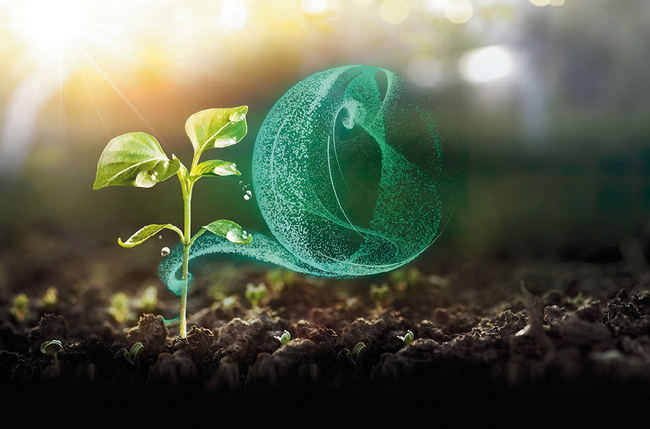 In the Digital Hub and the Green Innovation Zone at this year's Achema, Siemens will be demonstrating how industrial companies can efficiently combine digitization and sustainability.Comprehensive portfolio for a sustainable process industry
In the Digital Hub and the Green Innovation Zone at this year's Achema, Siemens will be demonstrating how industrial companies can efficiently combine digitization and sustainability.Comprehensive portfolio for a sustainable process industry
Siemens is taking an integrative approach at Achema this year. The company will be presenting itself in many relevant areas but will not have a large stand of its own. In addition to the Green Innovation Zone (Hall 6) and the Digital Hub, Siemens is part of several joint stands on various industry topics: with the electrical engineering association ZVEI, PROFIBUS and PROFINET International (PI) and with the Fieldcomm Group (all Hall 11).
In the Green Innovation Zone, Siemens is focusing this year on hydrogen and chemical recycling. Chemical recycling plays a decisive role on the way to a true circular economy in the process industry. In essence, the aim is to decompose waste, such as tires, batteries, and plastics, back into the raw materials that were used in their production, such as oil and gas. After reprocessing, the raw materials recycled in this way can in turn be used as feedstock for the chemical industry.
This is also the business idea of Pyrum Innovations. The startup company from the German state of Saarland has developed a novel pyrolysis technology that can be used to convert old tires back into primary raw materials. To be able to scale its technology quickly Pyrum Innovations relies on the entire automation portfolio and industry know-how of Siemens – from the web-based Simatic PCS neo process control system to intelligent measuring devices. Siemens and Pyrum Innovations will present more details in a joint presentation in the Green Innovation Zone at Achema.
Hydrogen an important element for green process industry
Low-carbon hydrogen is an important building block for decarbonizing entire industries as well as the energy and transportation sectors. With its hydrogen-enabled portfolio, Siemens serves process OEM, EPC and end customers to build and operate equipment modules or entire plants along the hydrogen value chain – from hydrogen production to conversion, storage, transport and utilization. Siemens will also be demonstrating what is involved in this process in several presentations in the Green Innovation Zone.
The backbone of competitiveness in the process industry is control technology. With the web-based Simatic PCS neo process control system, Siemens is contributing to comprehensive sustainability management at the central point of plant control. The location- and device-independent control capability of PCS neo allows operators to access the control system and control their plants from anywhere in the world. This eliminates the need to travel to individual plant locations for operation or instruction in the control system. In addition, existing plant components that were already running under other systems, such as SIMATIC PCS 7, can be integrated into the control system.
High demand for innovative software
In the Digital Hub in Hall 11, the focus is on digital transformation: potential for the process control community, technologies and use cases with a focus on software and platforms, cloud and infrastructure, and digital consulting. Siemens is also represented here with several topics. Eberle: "Especially in the areas of process optimization, modernization of existing plants or flexibilization of plants and capacities, there is an enormous demand for innovative digital solutions today. However, for the appropriate software to unleash its full power, companies must rely on integrated technology platforms that link all areas of production."
Asset performance management and modular production at the ZVEI joint booth
With the Asset Performance Suite, Siemens will showcase an offering from its new open and digital business platform Siemens Xcelerator. This plant asset management solution supports predictive maintenance of plant components such as pumps or valves, uses artificial intelligence to detect patterns in the operation of these components, and thus enables the highest possible reliability and efficiency for all assets in a plant (ZVEI joint booth, Hall 11).
For many industrial companies, the ability to produce in modules is a decisive step toward remaining competitive in the future. Different plant modules can thus be added to the production process as required and integrated directly into the process control system. This is made possible by the industry standard Module Type Package (MTP) in accordance with NAMUR recommendation NE 148. Siemens will also be showing how companies can use this production standard for themselves at the joint ZVEI booth.
For more information about Siemens at ACHEMA 2022, visit:
https://siemens.com/achema
Tackling wastewater challenges system-wide
Sulzer and Nordic Water: delivering technologies to solve wastewater problems, not just shift them
Blockages in municipal wastewater systems are costly for utilities, inconvenient for users and potentially harmful for the environment. This increased stress on the system leaves the operators to find a smarter approach to ensure network-wide reliability.
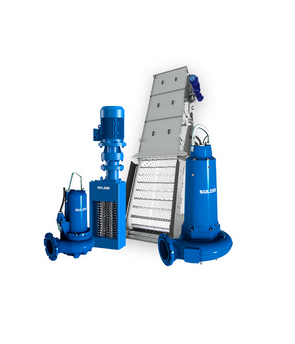 A broad range of solutions are required to ensure reliable wastewater treatment processesMunicipal wastewater systems are now receiving less water and more waste. This shift is a subtle one, but it is having a profound impact on network reliability and maintenance costs around the world. On one side of the equation, the desire to reduce excessive water consumption is encouraging households and businesses to change their behaviors, shifting towards more water-efficient appliances and machines. On the other, significant quantities of difficult, solid materials continue to find their way into wastewater systems.
A broad range of solutions are required to ensure reliable wastewater treatment processesMunicipal wastewater systems are now receiving less water and more waste. This shift is a subtle one, but it is having a profound impact on network reliability and maintenance costs around the world. On one side of the equation, the desire to reduce excessive water consumption is encouraging households and businesses to change their behaviors, shifting towards more water-efficient appliances and machines. On the other, significant quantities of difficult, solid materials continue to find their way into wastewater systems.
For utilities, tough fibrous wastes are particularly problematic. With less water flowing through the system, materials such as rags, nappies, wipes and face masks are more likely to drop out of the flow and accumulate. This can cause blockages, requiring expensive and inconvenient unplanned maintenance, potentially leading to environmental damage and significant fines due to sewer overflows.
Another challenge for many operators is handling the “first flush” of rain after an extended dry spell. This can be the trigger for a host of problems, as large volumes of solid material are imposed on network pumping stations and other vulnerable points in the wastewater system.
Stopping the block
One way to protect wastewater networks is to stop damaging solids reaching the places where they are likely to do most harm. Installing screens in network pumping stations to protect the pumps is one way to do this and such decisions should be supported by experts that can help with selection and dimensioning of the equipment.
An alternative approach involves the installation of equipment that is designed to cope with difficult solids. Clog-resistant wastewater pumps with large free passage can handle high levels of solid contamination thanks to a combination of clever geometry and robust materials. In the most challenging applications, grinders can be used to crush and shred solids in the flow to reduce the impact of the hard-to-handle material.
Any of these technologies can offer an effective and sustainable solution to blockage-prone pumping stations. However, focusing on the local fix sometimes produces new problems elsewhere. Fitting a clog-free pump in a small pumping station at the edge of the network might create a free pass for solids that will eventually settle and accumulate, causing problems further downstream.
Reducing the size of the solids too much, meanwhile, can have implications for wastewater treatment facilities as well. Screens at the beginning of the wastewater treatment process are a cost-effective and reliable way to capture and remove solids prior to treatment. If the solids are too small to be captured, that increases the load on subsequent sedimentation processes, driving up costs for the operator.
Networks that work
To avoid unintended consequences like these, utilities need to take a system-wide approach to the engineering of their wastewater networks. That requires a clear understanding of the loads imposed on the system, and access to a wide range of different types of equipment.
As one of the world’s largest suppliers of wastewater treatment technologies, Sulzer has long been a proponent of this approach. Every day, the company’s wastewater specialists work with customers to develop detailed risk profiles of assets and devise effective, cost-efficient solutions to address performance and reliability challenges.
Sulzer wastewater products are developed with network-wide performance in mind. Take the Monster Stack system used in the Muffin Monster grinder range, for example. The cutters in the stack are carefully sized to match real-world wastewater requirements. Larger cutters at the bottom of the stack make short work of heavier debris, while smaller cutters at the top give good results on lighter materials that tend to rise to the top of the flow.
Most importantly, however, Sulzer’s broad range of solutions means that the company’s experts are not tied to any single technology. They can work with customers to specify grinders, heavy duty pumps or specialized screens from the Nordic Water brand. They also have the skills to tie all those components together with smart control technology and provide support for installation, commissioning and maintenance activities.
The demands placed on wastewater networks are constantly evolving. For utilities, the key to their operation is a holistic, end-to-end design approach. With decades of expertise, a wide range of technologies and an open mind, Sulzer is the ideal partner to help deliver a reliable, sustainable and cost-effective system.
Outokumpu sets the new standard for the world’s most sustainable stainless steel – launching a product with 92% lower carbon footprint than the industry average*
Outokumpu is shaping the stainless steel market with its new emission-minimized product line, Circle Green. It has the smallest emission intensity in the world, with a 92% lower carbon footprint than the global average and 64% lower than Outokumpu’s regular production – which is already the current sustainability leader in the industry. The new standard for sustainable stainless steel is now set.
“We are extremely proud to introduce a new product line, Outokumpu Circle Green, which is truly an innovation in the stainless steel industry and a result of our focused learning journey. The first batch was produced in Tornio, Finland, and was delivered to one of our strategic customers, Fiskars Group, to use for cookware. I’m extremely proud that we have launched a product that has a true impact on our customers’ climate ambitions,” says Niklas Wass, Executive Vice President, Operations, at Outokumpu.
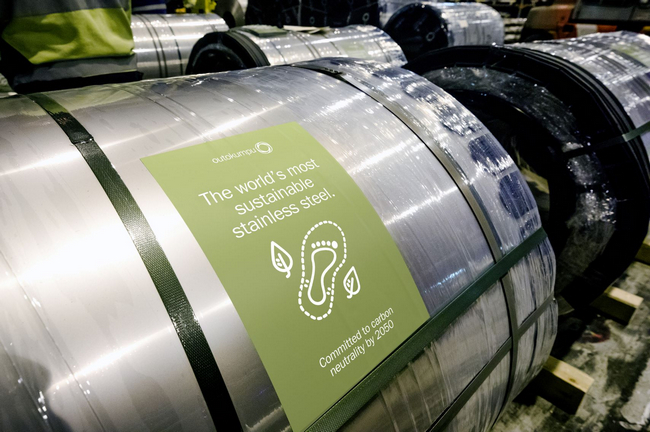
“We see increasing global customer demand for low carbon footprint stainless steels, from construction to heavy industry and consumer products. I’m very happy to say that Outokumpu is now ready to answer this demand. In this first phase, we will concentrate our efforts to serve a few strategic customers, but we are already looking at ways to scale up the production,” Wass says.
Bio-based materials used together in the production
Outokumpu achieved the unprecedented emission reduction with improvements throughout the whole stainless steel production chain. Reductions in upstream raw material emissions were key to this success as they contribute the majority of stainless steel’s total carbon footprint. Meticulous production and quality optimization led to higher energy efficiency. Biogas, biodiesel, bio coke, and low-carbon electricity have been used in production to eliminate 95% of all scope 1 and 2 CO2 emissions. While these bio-based materials have all been tested previously in production, they were used together for the first time ever to produce Outokumpu Circle Green.
“Our emission-minimized product answers the global need for more sustainable and long-lasting products that help to build a more sustainable future. The material was produced on an industrial scale with our existing production assets. This is a key step and an essential achievement towards meeting Outokumpu’s sustainability goals,” Wass says.
A global first with emission-minimized stainless steel production
The production of the new Outokumpu Circle Green is the first of its kind, as no other stainless steel manufacturer has been able to produce stainless steel with such low emission levels when taking into account all the climate emissions through the whole production chain including scope 1, 2 and 3. Climate compensating or offsetting has not been used in calculating the emissions and the focus has been on improving Outokumpu’s own processes and supply chain.
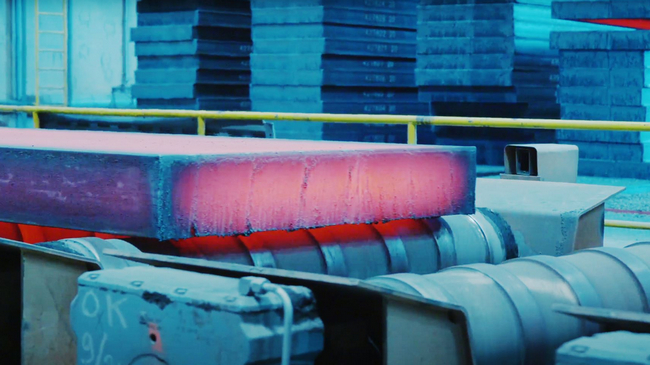
Outokumpu reviewed and optimized the emissions from each production step from the stainless steel melt process and energy production to transportation and raw material production. The emission reduction calculation includes all emission scopes according to the Greenhouse Gas Protocol method to give the full picture of the emissions.
Outokumpu is leading the global stainless steel industry in emissions reduction and carbon neutrality – the global work towards the Paris Agreement goals requires quick actions. Outokumpu is the only stainless steel producer to have its climate targets approved by the Science Based Targets initiative (SBTi).
“I would like to thank our Outokumpu team for making this possible. Our experts have been extremely committed to the historic project and the team spirit has been really high as we have been building a new step to a sustainable future. We will keep working towards a world that lasts forever,” Wass says.
*Source: ISSF calculation for stainless steel industry mean emissions
Outokumpu launches emission-minimized stainless steel
First turbine installed at notable Scottish wind farm extension
A leading renewables firm has successfully erected the first of 15 wind turbines at a major new wind farm that will bolster Scotland’s drive towards net zero.
The structure, totaling 156m in height, has now been installed, kicking off the next stage of development of the Kype Muir Extension – a wind farm that will feature 200m-high wind turbines able to deliver considerable improvements in both output and efficiency when compared to older models.
Its developer, Banks Renewables part of The Banks Group, aims to have the turbines generating renewable electricity by the end of 2022, helping combat the energy shortfall and overreliance on fossil fuel imports that has contributed to soaring energy prices.
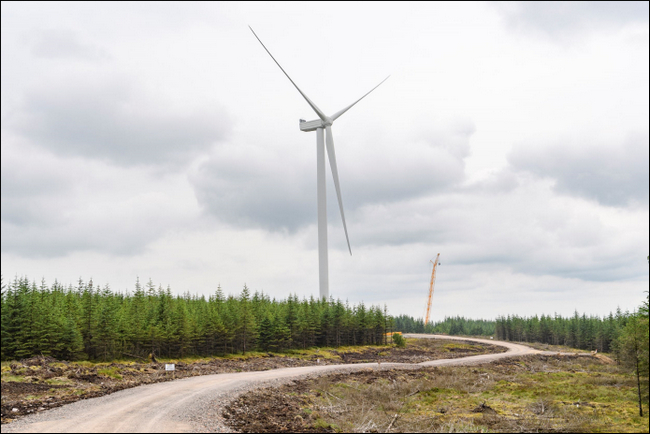
The South Lanarkshire wind farm is an extension of the current 26-turbine Kype Muir site which lies south of Strathaven - and will feature four 156m, three 176m and eight 200m-tall wind turbines.
As well as the environmental benefits of generating clean, renewable electricity for around 178,000 homes annually, the Kype Muir and Kype Muir Extension developments are expected to deliver around £21 million in funding to communities local to the area over the lifecycle of the wind farms.
Rachel Allum, principal development planner at Banks Renewables said: “To see the first turbine of the project installed and ready to go is a very proud moment for the team at Banks Renewables.
“This is a major milestone in what is set to have a positive impact on the local community. It will also have a much wider impact in its contribution toward net zero.”
Together, Kype Muir and Kype Muir Extension’s 41 turbines will have an installed electrical generating capacity of around 150MW. This is enough clean electricity to supply around 120,000 homes, equivalent to a city larger than Aberdeen.
A great deal of work has already been completed by Banks Renewables and its contractor R J McLeod in the lead up to the first turbine being erected. As well as creating access tracks to deliver components safely with minimum disruption to local communities and preparing foundations for the turbines themselves, the site team continues to carry out extensive environmental checks to ensure that operations are conducted with sensitivity towards birds, mammals or other protected species in the area.
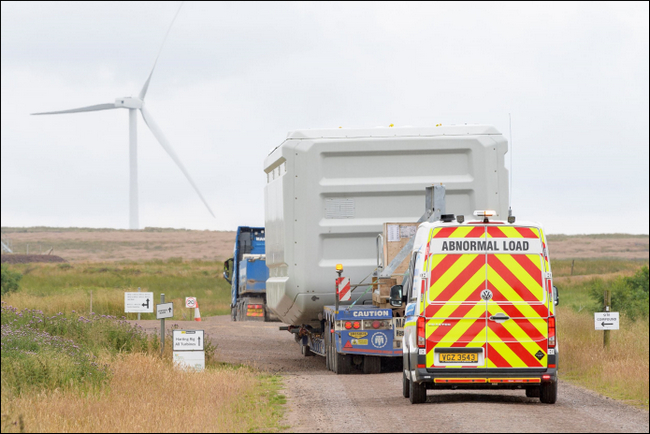
Banks Renewables has maneuvered its way through soaring material costs, supply chain disruption, and weather delays during turbine installation at Kype Muir Extension in order to deliver to the agreed timelines.
Rachel added: “We’re confident that we can be generating green electricity before the turn of the year which will add huge contributions towards Scotland’s net zero targets.
“Once completed, this project will deliver invaluable positives for its 30-year lifetime. From supporting the local community to its contribution to climate change targets, Kype Muir Extension is set to add a significant value once it’s up and running.”
Since planning permission was approved for the original Kype Muir Wind Farm in 2014, Banks have met with community groups and members to ensure the project and plan delivers the maximum benefits locally.
Kype Muir and Kype Muir Extension are set to deliver community benefits equating to more than £700,000 made available to surrounding communities each year.
The project is a flagship development for Banks Renewables and is where the company’s first Scottish Community Partnership was launched. With the introduction of Kype Muir Extension, the Hamilton-based firm will look to reinforce and enhance the principles of Community Partnership originally founded at Kype Muir.
To find out more about Banks Renewables Kype Muir Extension Wind Farm, please visit; https://www.banksgroup.co.uk/KypeMuirExtension
ANDRITZ has received final acceptance from Eldorado for biomass handling plant
ANDRITZ has successfully received the Final Acceptance Certificate for a biomass handling plant at Eldorado’s Onça Pintada site in Três Lagoas, Mato Grosso do Sul. This plant is part of the first thermoelectric power plant in Brazil to consume eucalyptus stumps and roots.
The plant will be able to generate 50 megawatts of electricity from an innovative source – eucalyptus stumps and roots, the parts of the trees not used in the pulp manufacturing process. This expands the capacity to generate energy from waste material originating from reforestation crops that are maintained by the company itself in the states of Mato Grosso do Sul and São Paulo.
The daily processing capacity is 1,500 tons of material that formerly went to waste in the forest – enough to generate the electricity needed to light up a city of 700,000 inhabitants in a fully sustainable way, and this power will also be fed to the Brazilian national grid.
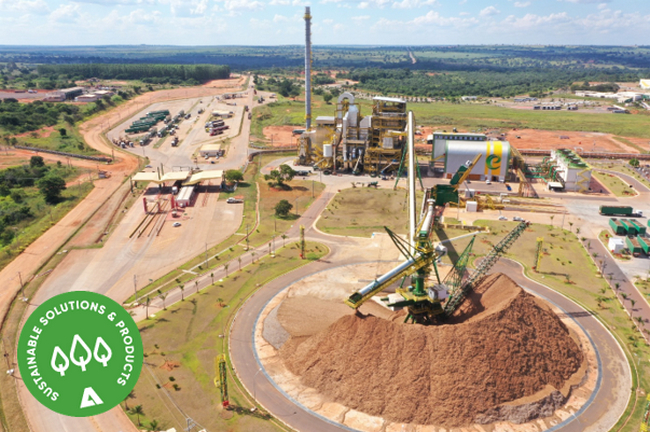 ANDRITZ Biomass Handling Plant at Eldorado. Photo: ANDRITZ
ANDRITZ Biomass Handling Plant at Eldorado. Photo: ANDRITZ
ANDRITZ has played a key role in the project – from the EPC model to design and supply of the unique solutions and technologies required to implement a generating system for renewable energy. Among the innovations are the truck dumpers designed to receive the chips for feeding the boiler. These chips are delivered by large-capacity vehicles.
The receiving system consists of two truck dumpers coupled to respective hoppers. There is a belt conveyor to receive the material from these hoppers and transport it to the pile. A stacker-reclaimer with a capacity of up to 40,000 m³ has the functions to form the pile and feed a second belt conveyor, which is responsible for transporting the material to the power boiler.
The project is a pioneering one and the first to use residues left over from pulp production. It promotes sustainable power generation initiatives, drastically reducing the impact on the environment and encouraging energy generation and pulp production that respects the boundaries of natural resources renewal.
ANDRITZ GROUP
International technology group ANDRITZ offers a broad portfolio of innovative plants, equipment, systems, services and digital solutions for a wide range of industries and end markets. ANDRITZ is a global market leader in all four of its business areas – Pulp & Paper, Metals, Hydro, and Separation. Technological leadership, global presence and sustainability are the cornerstones of the group’s strategy, which is focused on long-term profitable growth. The publicly listed group has around 27,400 employees and over 280 locations in more than 40 countries.
ANDRITZ PULP & PAPER
ANDRITZ Pulp & Paper provides sustainable technology, automation, and service solutions for the production of all types of pulp, paper, board and tissue. The technologies and services focus on maximum utilization of raw materials, increased production efficiency, lower overall operating costs as well as innovative decarbonization strategies and autonomous plant operation. Boilers for power generation, flue gas cleaning systems, various nonwoven technologies, panelboard (MDF) production systems, as well as recycling and shredding solutions for numerous waste materials also form a part of this business area. State-of-the-art IIoT technologies as part of Metris digitalization solutions complete the comprehensive product offering.
UNTHA launches cutter reconditioning service to boost shredder profitability and sustainability
UNTHA shredding technology has launched an innovative new cutter refurbishment service, to further improve its environmental performance – and reduce customers’ wear costs by up to 50%.
Cutting discs from UNTHA’s four shaft shredders can now be returned to the firm’s Austrian HQ for hardfacing and re-assembly – restoring them to their original dimensions with the same manufacturer quality seal.
The launch of the reconditioning service follows a €1.000.000 investment in a state-of-the-art CNC line and specially-adapted welding additives. It means customers can now repeat the hardfacing process several times, extending the overall service life and sustainability credentials of UNTHA’s shredding technology, and reducing the whole life running costs of UNTHA’s machines. The process is up to 50% more cost-effective than the price of a new cutter set, and such savings can be reaped multiple times.
“Some customers will know when the time is right for cutters to be refurbished, without our input, whereas others will be reliant on an inspection from our engineers – either way, we can support with the end-to-end process,” commented Bernhard Walkner, UNTHA’s key account manager. “Crucially, our original manufacturing quality standard is maintained, which means so too are the performance levels you could expect from one of our four shaft shredders, without having to invest in new cutters.”
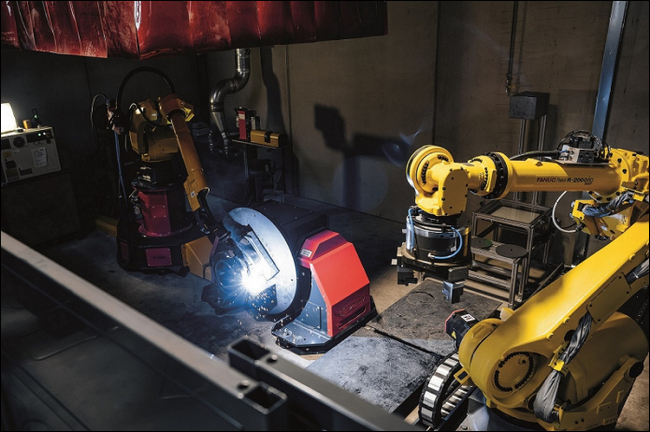 Cutter Reconditioning
Cutter Reconditioning
The cutter reconditioning process follows five key steps – the visual inspection and cleaning of the cutting set, preparation of the welding seam, hardfacing along the cutting geometry, precision milling, and final inspection and dispatch.
“The actual saving potential will vary depending on every individual customer’s operating hours, throughputs and application type,” continued Bernhard. “But an RS100 with an average cutter life of 900 hours, for example, can easily show 40% cost savings, when reconditioning instead of replacing. If you recondition three times, it soon add up to impressive five-figure numbers.
“If anyone needs help determining when the time is right for reconditioning, calculating the potential financial savings, and understanding the environmental benefits, let’s talk it through.”
There are more than 12,000 UNTHA shredders in operation worldwide. Earlier this year, the company – now with over 300 employees – announced record turnover in excess of €70m.
For further information about this service, please contact UNTHA UK on This email address is being protected from spambots. You need JavaScript enabled to view it. or call 0330 056 4455.
Metso Outotec to start repurchasing own shares for its share-based incentive plans
 The Board of Directors of Metso Outotec Corporation has decided to start repurchasing the company's own shares based on the authorization given by the 2022 Annual General Meeting. The shares shall be repurchased to be used as a part of the company’s share-based incentive plans. The maximum number of shares to be repurchased is 3,036,000 and the maximum amount to be used for the repurchase is EUR 30 million. The shares will be repurchased in public trading on Nasdaq Helsinki Ltd. in one or several instalments at the market price prevailing at the time of the purchase. The share repurchase will start on August 9, 2022, at the earliest and end by March 31, 2023, at the latest.
The Board of Directors of Metso Outotec Corporation has decided to start repurchasing the company's own shares based on the authorization given by the 2022 Annual General Meeting. The shares shall be repurchased to be used as a part of the company’s share-based incentive plans. The maximum number of shares to be repurchased is 3,036,000 and the maximum amount to be used for the repurchase is EUR 30 million. The shares will be repurchased in public trading on Nasdaq Helsinki Ltd. in one or several instalments at the market price prevailing at the time of the purchase. The share repurchase will start on August 9, 2022, at the earliest and end by March 31, 2023, at the latest.
The General Meeting held on April 21, 2022, authorized the Board of Directors to decide on the repurchase of a maximum of 82,000,000 of the company's own shares.
Metso Outotec has a total of 828,972,440 shares, of which the company currently owns 300,505 shares.
Further information:
Juha Rouhiainen, VP, Investor Relations, Metso Outotec Corporation, tel. +358 20 4843253, email: This email address is being protected from spambots. You need JavaScript enabled to view it.
PTC named Overall Leader in Augmented Reality Connected Worker Assessment from PAC
PTC has just announced that, for the fourth consecutive year, it has been named the overall leader and a “Best in Class” vendor for its Vuforia® augmented reality (AR) solution suite in PAC’s Innovation RADAR report.
- PTC’s Vuforia augmented reality solution suite described as “most comprehensive enterprise AR solution suite available in the market…”
The prestigious report assessed AR vendors’ support for connected workers in two criteria categories: competence and market strength.
The Farnborough-based company received the highest scores for both categories, whilst also garnering positive feedback from AR client references for addressing the highest priority industrial and enterprise AR use cases, and supporting a wide range of AR hardware options, from smartphones and tablets to wearable devices, such as the Microsoft HoloLens 2 and the RealWear Navigator 500.
“Our analysis shows that PTC’s Vuforia continues to be the most comprehensive enterprise AR solution suite available in the market,” said the report’s lead analyst and author, Arnold Vogt. “
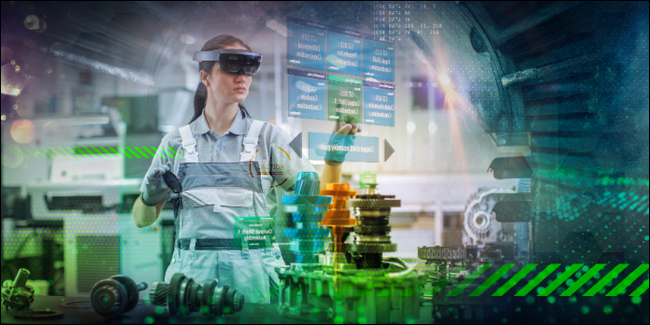
“It is well positioned to help its customers and their connected workers realise tangible value from AR for use cases like training, service and repair, and manufacturing quality inspection and validation.”
Michael Campbell, Executive Vice President and General Manager of Augmented Reality at PTC, added his thoughts: “Earning this recognition as the overall leader in PAC’s latest AR report reinforces the value that we deliver to our Vuforia customers and the strengths of our product and go-to-market strategies.”
He concluded: “We’re pleased to be at the forefront of the growing enterprise AR market as use cases expand, new hardware providers enter the space, and industrial companies realise increasing value from these solutions.”
The full report, “Open Digital Platforms for the Industrial World 2022” is available here.
About PAC
Pierre Audoin Consultants (PAC) is a content-based company with a consulting DNA. Since 1976, PAC has delivered focused and objective responses to the growth challenges of software & IT service vendors worldwide. We are the preferred partner for European software and IT service companies to define their strategy, strengthen market share, optimise GTM, and help position their thought leadership. PAC is proudly an analyst-lead consultancy spread over multiple locations across Europe. We cover market research for over 30 countries worldwide, delivered through our portfolio pillars Guidance, Insights and Visibility and our renowned research platform SITSI ®. For more information, please visit www.sitsi.com
About PTC (NASDAQ: PTC)
PTC enables global manufacturers to realise double-digit impact with software solutions that enable them to accelerate product and service innovation, improve operational efficiency, and increase workforce productivity. In combination with an extensive partner network, PTC provides customers flexibility in how its technology can be deployed to drive digital transformation – on premises, in the cloud, or via its pure SaaS platform.
Fluke announces top tools and technologies for improving operational efficiencies
Rising energy costs and more stringent legislation guiding sustainable practices are spurring companies to re-evaluate processes and seek new tools and technologies to reduce waste and overcome challenges in today’s industrial environments.
Fluke, a global technology leader in the manufacturer of compact, professional electronic test and measurement tools and software, today shares the top three trends that are enhancing operational efficiency in today’s industrial environments.
Challenges posed to industrial operations managers by the pandemic have now been superseded by the rising cost of energy, and the need to deliver on net zero ambitions. As the price of energy continues to increase, the need to reduce costs and deliver on shared sustainability goals intensifies for small-to-medium-sized enterprises through to large corporations.
Paul Feenstra, Vice President Fluke EMEA, at Fluke said: “We are working together with our customers to help drive new initiatives to improve operations, increase efficiencies, and take reliability to a new level in the 21st century.”
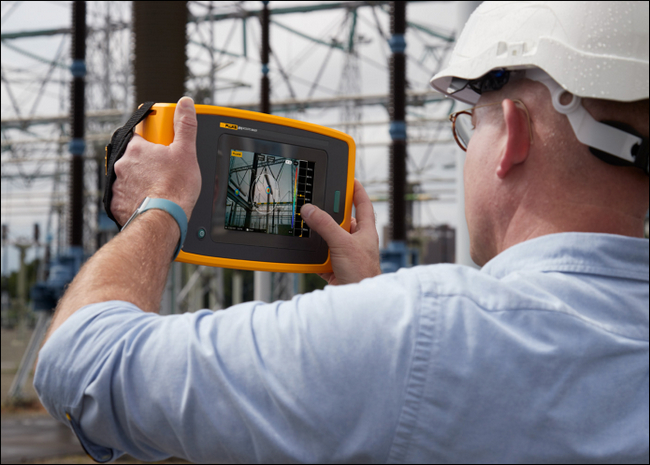 Fluke's ii910 Precision Acoustic Imager has dual uses for the detection of compressed air leaks and partical discharge
Fluke's ii910 Precision Acoustic Imager has dual uses for the detection of compressed air leaks and partical discharge
- Reducing energy costs with upgraded technology and cloud-based data monitoring
Approximately 90% of all companies use compressed air in some aspect of their operation, such that it is often referred to as the fourth utility. Recent developments in industrial acoustic imaging technology have enabled the fast identification of leaks in compressed air systems used in industrial and manufacturing environments. Fluke’s ii900 Industrial Acoustic Imager features an array of microphones, providing visualisation of sound field within an expanded field-of-view and at a distance of up to 70 meters, which enables maintenance teams to visually locate air leaks very quickly and accurately in compressed air systems.
Beyond the improvement of rugged handheld tools, monitoring practices are also evolving with the use of internet-connected instruments. Analysis and data is captured on a cloud platform allowing operators to monitor the key performance indicators (KPI) of compressed air systems including energy, electric power, flow, pressure and leakage flow. Fluke’s LeakQ™ Report Generator creates detailed air compressor leak reports from images captured by Fluke ii900 or the ii910 Precision Acoustic Imager and calculates the energy savings once the leaks are repaired.
- Using data to deliver predictive maintenance
For generations, maintenance professionals have used preventive maintenance to avoid equipment failures and turned to reactive maintenance when assets failed. With the emergence of Industrial Internet of Things (IIoT) technologies, maintenance professionals can now connect tools, software and sensors to collect, store and analyse multiple data sources in one place. The pandemic accelerated investment in technologies that make remote monitoring possible. The technology enables reliability and maintenance teams to meet up-time requirements no matter how fluid on-site staffing might be. The trend for remote monitoring will continue, with small-scale operations turning to remote condition monitoring services.
Artificial intelligence (AI) and machine learning (ML) have held the promise to quickly identify trends and adapt quickly to changing operational conditions. Software armed with prescriptive analytics is finally meeting up with modern condition monitoring hardware to spark a revolution in the use of AI/ML in maintenance operations.
Now a new race has emerged to pair that hardware and software with ML and AI algorithms. Companies, like Fluke, are working to combine technologies so that the software can identify trends, recognise data patterns and make specific recommendations for equipment maintenance.
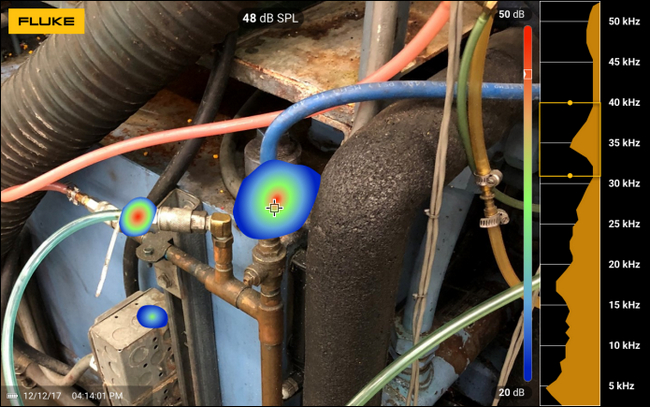 Fluke's ii900 Industrial Acoustic Imager captures still and video images of compressed air leaks at a facility
Fluke's ii900 Industrial Acoustic Imager captures still and video images of compressed air leaks at a facility
- Digital SI speeds integration of critical equipment measurements
The accelerated uptake in digital measurement solutions for industrial applications can save time and money, whilst facilitating a shift towards predictive maintenance for systems. Although modern measurement digital devices are typically not fit-and-forget solutions, the increase in digital measurement solutions paves the way for verification technologies that can help to reduce the maintenance burden on personnel, without compromising on accuracy or reliability.
Digital SI (International System of Units), an initiative created as part of the industry 4.0 revolution, relates to the creation of a globalised system to transmit calibration certification information electronically. This is critical as the exchange of data and the data itself are the basis of highly automated industrial processes. The system ensures measurement traceability from all calibrations performed and enables sharing of information in a paperless manner. This speeds up the integration of measurements that can be performed using critical test equipment as part of an integrated factory enhancing maintenance efficiency and plant efficiency.
“The tests we have faced within the last 24-36 months is delivering a growing awareness among top management that fundamental changes in maintenance best practice need to occur in order to protect the bottom line,” said Paul Feenstra.
“This is music to the ears of progressive industrial managers who have been advocating for investments to improve efficiencies and reliability of systems. Now is the time to make the case to adopt innovative technologies, tools, and processes to ensure your company maintains a competitive edge and thrives in this new environment.”
For more information about Fluke’s specialist products and services, go to: https://www.fluke.com/en.
About Fluke: Fluke’s mission is to be the world leader in compact, professional electronic test tools. The company’s products are used by technicians and engineers in service, installation, maintenance, manufacturing test, and quality functions in a variety of industries throughout the world. Founded in 1948, Fluke has offices in 13 European countries and distributes its products to over 100 countries around the globe. The company’s European revenues contribute approximately 40 per cent of worldwide sales.
Fluke’s headquarters are located in Everett, Washington State and the company employs over 2,500 people internationally. Its European sales and service headquarters are located in Eindhoven, The Netherlands.
FLUKE is a registered trademark of Fluke Corporation. For more information, visit the Fluke website at http://www.fluke.com.
ANDRITZ receives the 15th order to deliver a high-efficiency PowerFluid circulating fluidized bed boiler to Japan
International technology group ANDRITZ has received another order from Toyo Engineering Corporation in Japan to supply a 50-MW PowerFluid circulating fluidized bed (CFB) boiler on EPS basis. The boiler will be part of the biomass power plant in Gobo, Wakayama Prefecture, in Japan. Start-up is planned for 2025.
ANDRITZ will supply a biomass boiler and flue gas cleaning system to Wakayama Gobo Biomass Power Plant G.K. in Japan.
The ANDRITZ PowerFluid (CFB) will be designed with a reheat system and high steam parameters and integrated into a biomass-fired power generation facility to be fueled by wood pellets and palm kernel shells. With its state-of-the-art technology, it is the perfect solution to meet CO2 reduction targets and contribute towards carbon neutrality in Japan. The biomass power plant will be capable of supplying power for roughly 110,000 Japanese households.
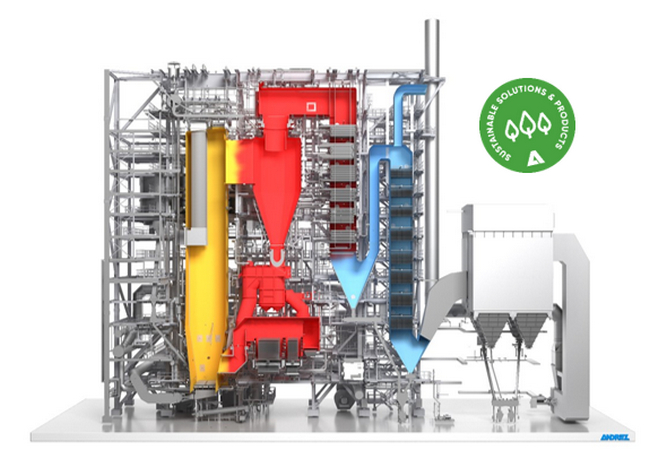 ANDRITZ PowerFluid circulating fluidized bed boiler. Photo: ANDRITZ
ANDRITZ PowerFluid circulating fluidized bed boiler. Photo: ANDRITZ
Biomass boilers and flue gas cleaning systems are part of the comprehensive ANDRITZ product portfolio of sustainable solutions that help customers to achieve their own sustainability goals in terms of climate and environmental protection.
This order once again confirms ANDRITZ’s strong partnership with Toyo Engineering Cooperation. The project is the 12th to be conducted in cooperation with Toyo Engineering. ANDRITZ is proud to be part of this remarkable project and make another important contribution toward the Japanese power industry’s move from fossil fuel to renewable energy resources.
ANDRITZ GROUP
International technology group ANDRITZ offers a broad portfolio of innovative plants, equipment, systems, services and digital solutions for a wide range of industries and end markets. ANDRITZ is a global market leader in all four of its business areas – Pulp & Paper, Metals, Hydro, and Separation. Technological leadership, global presence and sustainability are the cornerstones of the group’s strategy, which is focused on long-term profitable growth. The publicly listed group has around 27,400 employees and over 280 locations in more than 40 countries.
ANDRITZ PULP & PAPER
ANDRITZ Pulp & Paper provides sustainable technology, automation, and service solutions for the production of all types of pulp, paper, board and tissue. The technologies and services focus on maximum utilization of raw materials, increased production efficiency, lower overall operating costs as well as innovative decarbonization strategies and autonomous plant operation. Boilers for power generation, flue gas cleaning systems, various nonwoven technologies, panelboard (MDF) production systems, as well as recycling and shredding solutions for numerous waste materials also form a part of this business area. State-of-the-art IIoT technologies as part of Metris digitalization solutions complete the comprehensive product offering.
